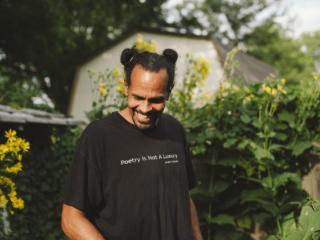Kathryn Bond Stockton is an English professor and queer theorist and a self-professed lover of kissing. She wrote a whole book just to make out what kissing means in our lives.More
Interviews By Topic
In a dark world, poet Ross Gay recommends "stacking delights." Share what you love, he says — not what you hate.More
Ebony Thomas doesn't see Hermione from the Harry Potter series as Black. But a whole new generation of young Black girls do, and they're using fan fiction and online communities to re-imagine a witch they can identify with more deeply.More
Inspired by "Alice in Wonderland" and "Buffy the Vampire Slayer," L.L. McKinney's Nightmare-Verse fantasy series reimagines Alice is a young Black girl from Atlanta. She told Steve Paulson that this Alice’s superpower is self confidence.More
Archeologist Eric Cline says a "perfect storm" of calamities led to the collapse of the Late Bronze Age. He points out that we face many of the same challenges today.More
Historian Jo Paoletti speaks with Shannon about gender's ever-changing relationship with fashion.More
The most iconic designers have always done more than invent new looks — they help re-imagine our lives, our world. As Steve Paulson discovered when he met designer agnés b.More
Renowned classicist Mary Beard says we have lots to learn from Ancient Rome, including insights into how empires rise and fall.More
Could you trade the convenience of instant-purchase online clothing stores for a wardrobe you made yourself? Carolyn Smith went for an even bigger challenge: only wearing clothing she made by hand for a full year.More
Avery Trufelman hosts "Articles of Interest," a six-part podcast from "99 Percent Invisible" about some iconic items of clothing — from blue jeans to Hawaiian shirts to pockets. Anne wanted to know how that work connects to what she wears every day.More
Choosing what to put on your body is more than just taking something off a hanger and praying it fits. When you get dressed in the morning, you’re constructing an identity. That’s complicated, as producer Angelo Bautista discovered.More
Norwegian novelist Karl Ove Knausgaard has published six volumes of intensely personal descriptions of his daily life. But his “honesty” cost him some of his closest relationships, including his marriage.More
Priya Parker challenges us to question why we have certain traditions, and to be open to creating new ones that fit this unusual holiday time.More
Terese Marie Mailhot's brave and beautiful memoir about life on a Pacific Northwest reservation is making waves. She originally intended to tell her story as fiction, but ultimately made the difficult decision to write the whole, painful truth.
More
In 1914, over the week leading up to Christmas day, the opposing troops sang carols to each other, played ball and exchanged gifts, in spite of their generals’ wishes. Historian Stanley Weintraub says that the Christmas Truce was a one-time-only event.More
Stephen Sondheim is the reigning genius of musical theater, with credits ranging from "West Side Story" and "Gypsy" to "Sweeney Todd "and "Into the Woods." In this interview from 2013, Sondheim gives Steve Paulson a few pointers on how to write both music and lyrics.More
Every year, at holiday time, "H is for Hawk" author Helen Macdonald reads this tale of a boy who finds out he's one of the "old ones," part of a series from author Susan Cooper. She says it reconnects her with a sense of wonder inspired by what might lurk beneath the surface of the seen world.More
Would Sondheim prefer to work on music or lyrics? What was it like to work on West Side Story? What's his take on musical critics? You can hear that — and a whole lot more — in this extended interview with him from 2013.More

















